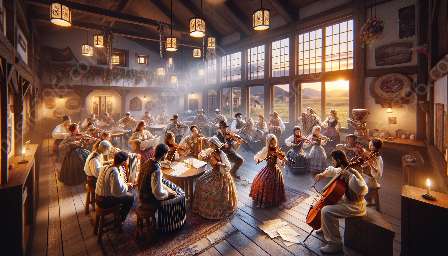North American classical music encompasses a rich and diverse tradition that incorporates elements from various cultural influences, resulting in a unique sound that sets it apart from other classical music genres worldwide. This article delves into the distinct characteristics of North American classical music, discussing its compatibility with North American music and its contribution to the global music landscape.
Historical Context
The history of North American classical music is deeply intertwined with the colonization of the region, as European settlers brought their musical traditions with them, laying the foundation for what would later develop into a distinct North American classical tradition. Over time, the influence of indigenous music and African musical traditions added layers of complexity and diversity to the genre, giving rise to a distinctively North American sound.
Integration of Diverse Cultural Influences
One of the key characteristics of North American classical music is its seamless integration of diverse cultural influences. This genre reflects the melting pot of cultures that define North America, incorporating elements from European, indigenous, African, and other global musical traditions. This integration results in a rich tapestry of sounds and textures, creating a musical landscape that is both familiar and innovative.
Exploration of Folk and Popular Music Elements
North American classical music often explores folk and popular music elements, blurring the boundaries between classical and non-classical genres. This incorporation of folk and popular music elements adds a sense of accessibility and relatability to North American classical compositions, making it appealing to a wider audience and contributing to its unique identity.
Emphasis on Innovation and Experimentation
North American classical composers are known for their emphasis on innovation and experimentation. This genre encourages composers to push artistic boundaries, exploring new techniques, instrumentation, and styles, while maintaining a deep respect for the classical tradition. As a result, North American classical music continuously evolves, reflecting the dynamism and creativity of its composers.
Collaboration with Other Art Forms
North American classical music often collaborates with other art forms, such as dance, visual arts, and multimedia, to create multidisciplinary works that transcend traditional boundaries. This collaborative approach adds a layer of depth and interactivity to North American classical performances, offering audiences a multi-sensory experience that engages both the intellect and the emotions.
Influence on North American Music
North American classical music has also had a significant influence on other genres of North American music, contributing to the development of jazz, blues, and contemporary popular music. The fusion of classical techniques with various musical styles has resulted in a distinctive North American musical landscape that continues to evolve and inspire artists across genres.
Global Impact
While rooted in North American traditions, classical music from this region has made a significant impact on the global music scene. Its incorporation of diverse cultural influences and innovative spirit has contributed to the enrichment of the worldwide classical music repertoire, fostering cross-cultural understanding and appreciation.
Overall, the key characteristics of North American classical music lie in its diverse cultural influences, integration of folk and popular music elements, emphasis on innovation and experimentation, collaboration with other art forms, influence on North American music, and global impact. These qualities make North American classical music a dynamic and influential force in the realm of classical music, bridging the gap between tradition and innovation while leaving a lasting imprint on the global music landscape.










































